VENUE SPOTLIGHT: The Fillmore (San Francisco, CA)

3 November 2017
PERHAPS ONE OF THE MOST FAMOUS VENUES IN THE WORLD, THE FILLMORE
 Perhaps one of the most famous venues in the world, The Fillmore – originally called the Majestic Hall – was built in 1912 and used primarily as a dance hall and academy. It wore this and one other disguise for a substantial part of the century (the other being a roller rink in the ‘40s), until its true identity and purpose were eventually discovered in 1952. The man responsible was businessman Charles Sullivan, who took over the property and envisioned it as a performance space, specifically for prominent black musical talent and subsequently became known as “the mayor of Fillmore” for more than a decade. In 1965, a year before Sullivan was tragically murdered, he was introduced to concert promoter Bill Graham, who began booking events at the space, and ultimately took over in 1966, ushering a new era for the stately, historic venue.
Perhaps one of the most famous venues in the world, The Fillmore – originally called the Majestic Hall – was built in 1912 and used primarily as a dance hall and academy. It wore this and one other disguise for a substantial part of the century (the other being a roller rink in the ‘40s), until its true identity and purpose were eventually discovered in 1952. The man responsible was businessman Charles Sullivan, who took over the property and envisioned it as a performance space, specifically for prominent black musical talent and subsequently became known as “the mayor of Fillmore” for more than a decade. In 1965, a year before Sullivan was tragically murdered, he was introduced to concert promoter Bill Graham, who began booking events at the space, and ultimately took over in 1966, ushering a new era for the stately, historic venue.
San Francisco was changing. The Beats had already virtually taken over North Beach, paving the way for the hippie movement of the 1960s, as tendencies towards radical politics and anti-war sentiment were brewing throughout the nation. San Francisco was quickly becoming one of the most dynamic hubs of counterculture in the world, and though the artistic community as a whole were important contributors to these ideals, Graham sought to focus on bringing the music of the Haight-Ashbury communities to the world’s stage in particular, and his key to the world was The Fillmore. Through his events, the psychedelic music of Moby Grape, Jefferson Airplane, The Doors, The Byrds, Jimi Hendrix became synonymous with counterculture and San Francisco as a whole. Of course, this group also included the Grateful Dead, who played the venue fifty-one times between 1965 and 1969 alone. In just a few short years, Bill Graham and The Fillmore changed the face of American music forever.
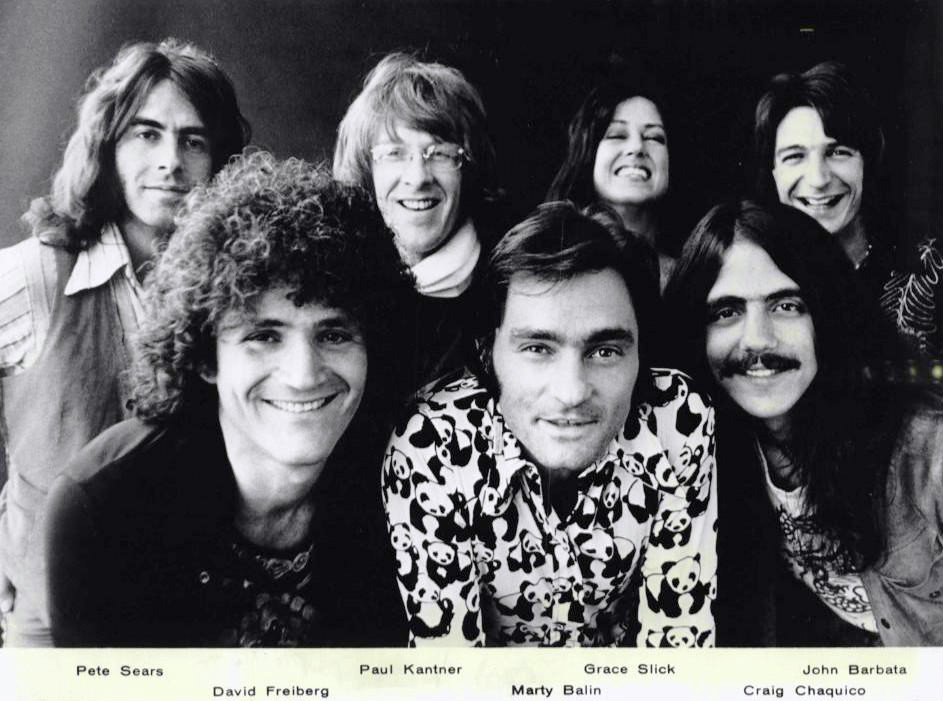
Today, it still stands, regal and broad, on the corner of Geary and Fillmore. Its ownership has fluctuated greatly over the many years since Graham’s heyday, which ended around 1968. The Stooges and Grateful Dead were mainstays for a few years as the venue changed hands and became the Elite Club, which eventually became a hub for the burgeoning punk movement.
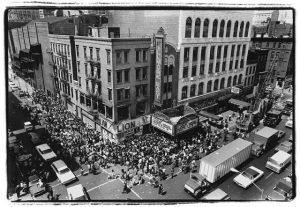 Graham reassumed management in the 1980s, but damages sustained during the 1989 Loma Prieta Earthquake caused the space to close, and would remain as such until the mid-1990s—a few years after Graham died in a helicopter crash—when it was renovated, retrofitted, and reopened under new management. Since then it has bounced back extraordinarily, becoming yet again a focal point for performances of a wide variety of musical genres. Its popularity continued to grow, and now operates, somewhat ironically, under the supervision of Live Nation, which is exactly the kind of large conglomerate of which the hippie movement would greatly disapprove. Regardless of the space’s associations, the original energy and peaceful atmosphere still hangs around like a gentle fog.
Graham reassumed management in the 1980s, but damages sustained during the 1989 Loma Prieta Earthquake caused the space to close, and would remain as such until the mid-1990s—a few years after Graham died in a helicopter crash—when it was renovated, retrofitted, and reopened under new management. Since then it has bounced back extraordinarily, becoming yet again a focal point for performances of a wide variety of musical genres. Its popularity continued to grow, and now operates, somewhat ironically, under the supervision of Live Nation, which is exactly the kind of large conglomerate of which the hippie movement would greatly disapprove. Regardless of the space’s associations, the original energy and peaceful atmosphere still hangs around like a gentle fog.
"While you wait, taking a tour of the venue’s past via the poster-lined walls is always a treat"
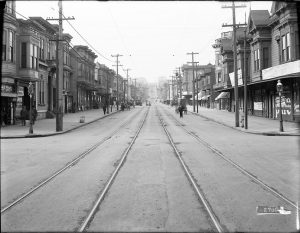
Divisadero Street and Post Street | August 15, 1910
And if there’s anything The Fillmore is no stranger to, it’s fog. San Francisco sees some degree of fog almost every day of the year, especially during the summertime months, and being situated at Fillmore Street, it lies just a few blocks east of Divisadero Street, known locally as the “fog line,” as its locale is usually where the fog starts to break down as it heads in from the coast. Remnants are often felt in the evening hours as we round the corner onto Geary and hustle toward the door, the soft cold drops urging us to hurry inside. We are briskly frisked for weapons (as is the custom these days, unfortunately), scanned, and stamped, and then ushered upstairs, where we are each individually received by an official greeter. What lies ahead is the breathtaking auditorium, with its high ceilings adorned with ornate chandeliers that dangle like earrings from the darkness above—a grand entry into a world of gorgeous sound, power, and light. In fact, the lighting was one of the venue’s original draws, as it was originally designed by Danny Williams for a run of shows by the Velvet Underground as part of Andy Warhol’s Exploding Plastic Inevitable performance installation. Williams then continued engineering lighting systems at the venue, and his designs became the new standard, without which most modern setups would not exist.
The Fillmore also boasts an impressive mezzanine that wraps around the main floor. A trip upstairs to the Poster Room reverberates with history, as hundreds of Fillmore concert posters line the walls, floor to ceiling, invoking the sounds and colors of decades past. T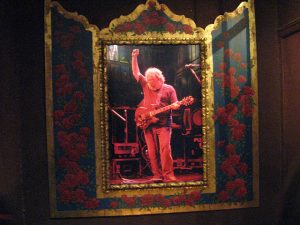 he Poster Room also offers specialty cocktails not available elsewhere inside the venue; the Basil Gimlet is to die for; just be careful of stampedes of younger fans racing up the stairs as you descend, often sending you—and your $8 cocktail—into the giant portrait of Jerry Garcia that hangs above the landing like some big, fuzzy guardian. Luckily, the bartenders up in the Poster Room will often refill your drink if such an event does occur, as well as present you with a food menu, sure to satisfy any palette. While you wait, taking a tour of the venue’s past via the poster-lined walls is always a treat, and once it’s time to return to the fray, if you don’t feel like standing on the floor, you can enjoy the view provided by the venue’s house left balcony--you may even snag one of the few seats positioned near one of the archways—if you’re lucky…though I often am not, save for one time I was at the venue doing press for a Youth Lagoon show during his final tour. I ended up giving my seat away to a very drunk man though, for fear that he may topple over the side accidentally if not given the opportunity to plant himself somewhere. Oh, the burden of being a decent human being. Sigh.
he Poster Room also offers specialty cocktails not available elsewhere inside the venue; the Basil Gimlet is to die for; just be careful of stampedes of younger fans racing up the stairs as you descend, often sending you—and your $8 cocktail—into the giant portrait of Jerry Garcia that hangs above the landing like some big, fuzzy guardian. Luckily, the bartenders up in the Poster Room will often refill your drink if such an event does occur, as well as present you with a food menu, sure to satisfy any palette. While you wait, taking a tour of the venue’s past via the poster-lined walls is always a treat, and once it’s time to return to the fray, if you don’t feel like standing on the floor, you can enjoy the view provided by the venue’s house left balcony--you may even snag one of the few seats positioned near one of the archways—if you’re lucky…though I often am not, save for one time I was at the venue doing press for a Youth Lagoon show during his final tour. I ended up giving my seat away to a very drunk man though, for fear that he may topple over the side accidentally if not given the opportunity to plant himself somewhere. Oh, the burden of being a decent human being. Sigh.
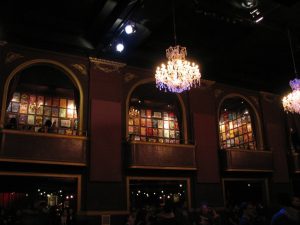 I often imagine what it was like walking into The Fillmore back in the ‘60s, before us threats the likes of the Las Vegas shooter started breathing down the collective necks of us lowly concertgoers. It must’ve been a very different place in some ways, but something tells me that much of it is the same, from the buckets of complimentary apples to the top-hat wearing greeter that welcomes each patron that passes through the door. When you step into the Fillmore, you not only feel the history that has already been made there, you feel it happening at that very moment.
I often imagine what it was like walking into The Fillmore back in the ‘60s, before us threats the likes of the Las Vegas shooter started breathing down the collective necks of us lowly concertgoers. It must’ve been a very different place in some ways, but something tells me that much of it is the same, from the buckets of complimentary apples to the top-hat wearing greeter that welcomes each patron that passes through the door. When you step into the Fillmore, you not only feel the history that has already been made there, you feel it happening at that very moment.
Find them here: Thefillmore.com







